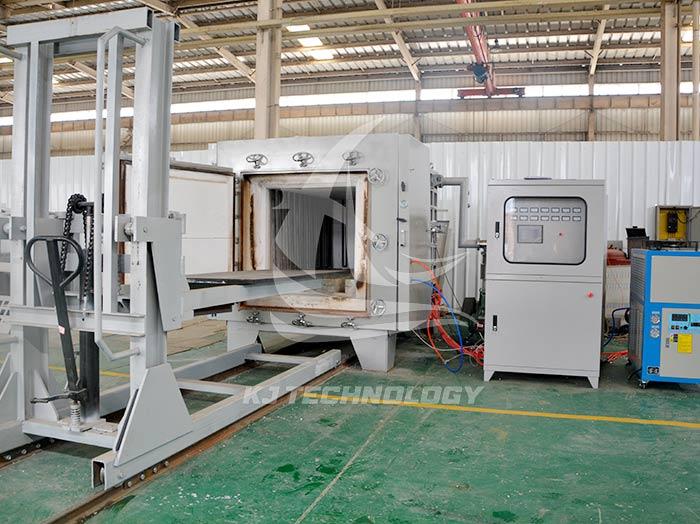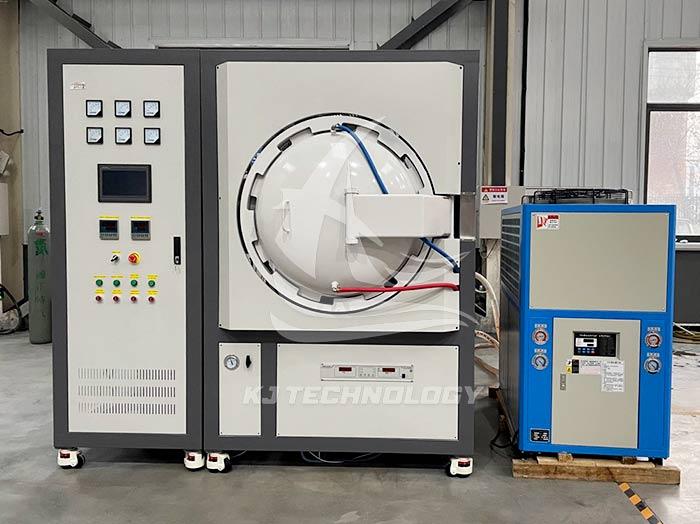Common faults and solutions of laboratory graphite vacuum furnace
 08-06-2025 Author: KJ technology
08-06-2025 Author: KJ technology
The common faults and solutions of laboratory graphite vacuum furnaces can be summarized into the following categories, covering core modules such as vacuum system, heating system, temperature control system, and mechanical structure:
1. Vacuum system malfunction
Insufficient vacuum degree or slow pumping
Possible reasons:
Vacuum pump malfunction (such as pump oil contamination, insufficient oil volume, and aging parts).
Seal failure (aging or deformation of sealing rings at furnace doors and pipeline interfaces).
Valve or pipeline blockage (failure of pneumatic valve operation, residual debris in the pipeline).
Vacuum gauge error (sensor failure or calibration deviation).
resolvent:
Check the vacuum pump: observe the color of the pump oil (if it turns black or cloudy, it needs to be replaced), measure the pump port pressure (if it is lower than the standard value, the pump needs to be disassembled for maintenance).
Test sealing: Apply soapy water or use a helium mass spectrometer leak detector to check the connections of furnace doors, flanges, etc., and replace aging sealing rings.
Cleaning pipelines: Remove filters and valves, remove foreign objects, and check the working status of solenoid valves.
Calibrate vacuum gauge: Compare with standard pressure gauge, recalibrate or replace faulty sensor.
Vacuum pump has loud noise or fuel injection
Possible reasons:
The coupling of the vacuum pump is worn or broken.
The O-ring of the suction valve has come loose.
resolvent:
Replace the coupling.
Remove the vacuum tube from the pump nozzle, remove the suction nozzle, take out the compression spring and suction valve, stretch the O-ring, and re insert it into the groove.
2. Heating system malfunction
Insufficient or unable to heat up
Possible reasons:
Power failure (poor plug contact, broken power cord).
Heating element damage (graphite heating rod or heating wire burned or oxidized).
Solid state relay failure (breakdown or aging causing disconnection of heating circuit).
resolvent:
Check if the power circuit and switch are functioning properly, and use a multimeter to measure the resistance value of the heating element.
Replace damaged heating elements or solid-state relays.
Uneven heating
Possible reasons:
The layout of materials inside the furnace is unreasonable, resulting in uneven heat distribution.
Heating element aging or damage, local power shortage.
resolvent:
Adjust the layout of materials inside the furnace to avoid excessive stacking.
Check the resistance value of the heating element and replace any aging or damaged components.
3. Temperature control system malfunction
Abnormal temperature (too high or too low)
Possible reasons:
Temperature controller parameter setting error or malfunction.
Thermocouple open circuit, short circuit or poor contact.
Sensor signal interference (poor electromagnetic shielding).
resolvent:
Check the parameters of the thermostat and refer to other thermostats in normal use.
Use a multimeter to check the resistance value of the thermocouple and replace the damaged thermocouple.
Use shielded cables, keep away from strong electrical lines, and ground them.
The temperature display fluctuates greatly
Possible reasons:
Poor contact of thermocouple probe.
The PID adjustment function of the thermostat is abnormal.
resolvent:
Re fix the thermocouple probe to ensure good contact.
Reset the temperature controller parameters and check the PID adjustment function.
4. Mechanical structural failure
Poor closure of furnace door
Possible reasons:
Deformation of hinges, failure of locks, or deformation of furnace body.
The sealing strip is damaged or there are foreign objects on the door panel.
resolvent:
Correct the hinge position, replace the deformed lock buckle or repair the furnace body.
Clean the sealing strip and foreign objects on the door panel to ensure sealing.
Fan abnormal noise or jamming
Possible reasons:
Fan bearings lack oil and motor screws are loose.
Foreign objects invade the interior of the wind turbine.
resolvent:
Disassemble the fan to clean foreign objects and replenish lubricating oil.
Tighten the fixing bolts of the motor and check the wear of the bearings.
5. Other common faults
Cooling system malfunction
Possible reasons:
Scaling in the water cooling pipeline or malfunction of the water pump.
Insufficient cooling water supply or high temperature.
resolvent:
Acid wash the scale, replace the water pump or add a filtering device.
Check the cooling water supply system to ensure normal water flow and temperature.
Program logic error
Possible reasons:
The PLC or industrial computer program is abnormal, causing instruction confusion.
resolvent:
Restart the control system, check the code logic, and restore the factory settings.








